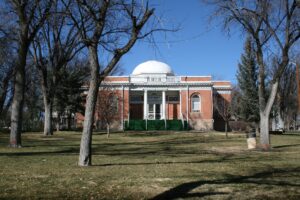The classical architectural vocabulary that was refined over time by the Greeks, Romans and Renaissance builders found a home in New Mexico beginning with the Territorial style and later with early 20th century Neoclassical Revival inspired by the Chicago World's Fair of 1893. As New Mexico grew dynamically before statehood, the Classical Revival was expressed in nearly every town of consequence in the new state, and best articulated by frontier architects, brothers I.H. Rapp and W. Rapp of Trinidad and Santa Fe. The white classical columns often contrasted handsomely with red brick walls and were sometimes expressed in limestone and marble.>
- Posts: 15 -
Arthur Johnson Memorial Library (Old Post Office)

This building was originally the Raton Post Office and was built during the WPA era. Paintings by various well known New Mexico artists can be viewed in the library. 244 Cook Ave. Raton, NM 87740 | (575) 445-9711 openmon: 1-6pm | tue: 10am-6pm | wed: 10am-6pm | thu: 10am-9pm | fri: 10am-6pm Read more…
Belén Hotel

Constructed 1910. The Belén Hotel was quickly built to accommodate the surging railroad business enabled by the rerouting of the major Santa Fe Railroad train traffic through Clovis and the so-called Belén cut-off. The building was purchased over a decade ago by famed artist Judy Chicago and her husband Donald Read more…
Carnegie Library

Constructed 1904 Las Vegas Carnegie Library was one of three Carnegie Libraries built in New Mexico, along with Raton and Roswell. A grant of $10,000 from the Andrew Carnegie fund helped build the library, and Las Vegas is the only active Carnegie Library remaining in the state. The building was Read more…
Carnegie Park

Carnegie Park was one of two city parks platted by the City of East Las Vegas soon after the Santa Fe Railroad arrived in 1879. Along with Lincoln Park, the two Las Vegas city parks are among the best preserved 19th Century parks in New Mexico. Laid out in a Read more…
Central Hotel

Constructed 1915. The Central Hotel is similar in architectural style and construction to its more substantial neighbor across the street, the Belén Hotel. The Central also thrived on the heavy railroad commerce ushered into Belén by the Santa Fe railroad after the Belén Cut-off was completed in 1907. The Central Read more…
Chaves County Courthouse

Constructed 1911. The Chaves County Courthouse was built in 1911, and designed by Isaac H. Rapp of the distinguished Rapp and Rapp architectural firm of Trinidad, Colorado. The Courthouse is one of the most imposing civic buildings in New Mexico, an outstanding example of the monumental civic Beaux-Arts style. Chaves Read more…
Douglas Sixth Street Historic District

Constructed 1900 An entire new city was platted between the Gallinas River and the Railroad in East Las Vegas after 1879. The two towns East Las Vegas and West Las Vegas would remain separate municipalities until consolidation in 1970. The commercial district of East Las Vegas was centered on the Read more…
E. Romero Hose and Fire Co.

Constructed 1909 Built in 1882, burned and rebuilt in 1909, the E. Romero Hose & Fire Building is the home of the first volunteer fire department in New Mexico. The original wood frame fire house was replaced by the brick building in 1909. The 1913 Sanborn map notes for the Read more…
Harding County Courthouse

Constructed 1922. The Harding County Courthouse, in Mosquero, is a handsome Neo-classical building with strong Greek Revival style accents, originally built to serve the county as a school. Named for President Warren G. Harding, Harding County is the least populated of all New Mexico counties, with less than 800 residents. Read more…
Lincoln Park Historic District

Constructed 1890 Lincoln Park was one of two municipal parks platted in the City of East Las Vegas after the railroad steamed into the town on July 4, 1879. Lincoln Park’s close proximity to the railroad district two blocks away made it a popular location for housing for Santa Fe Read more…